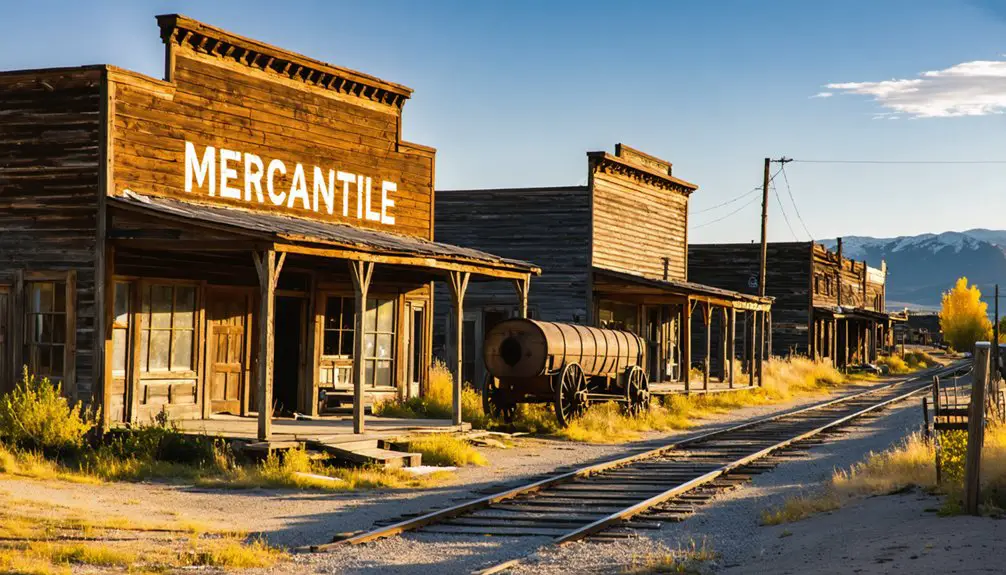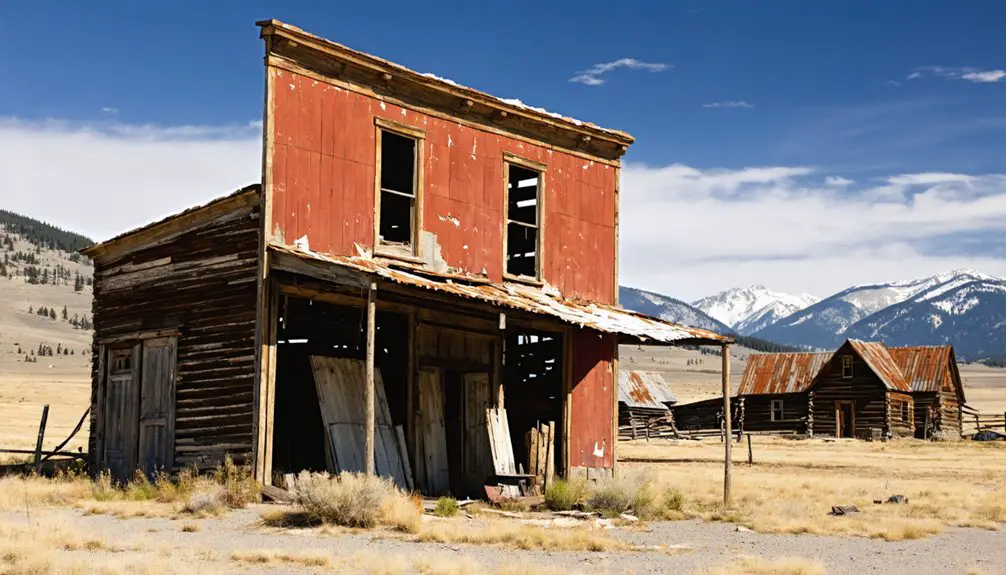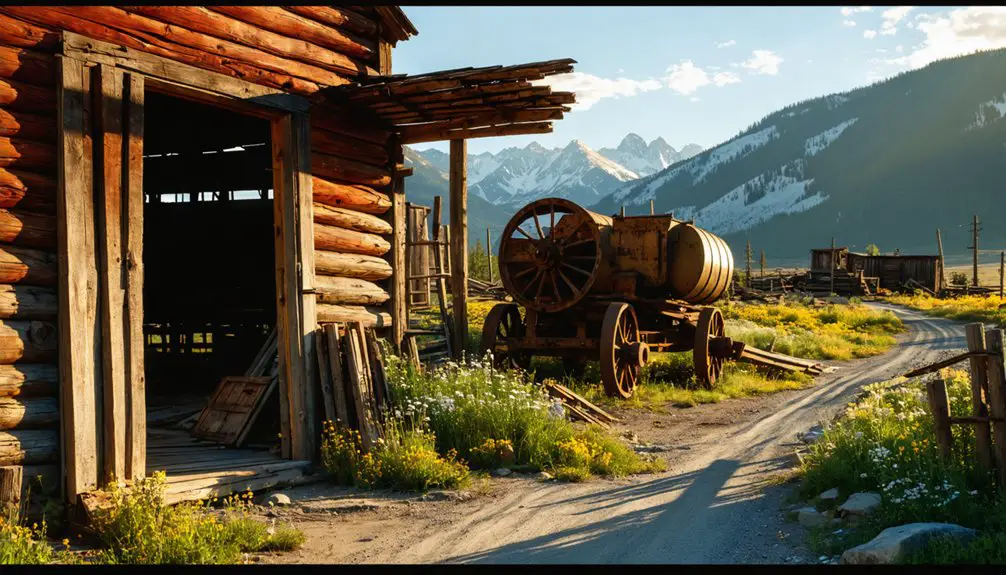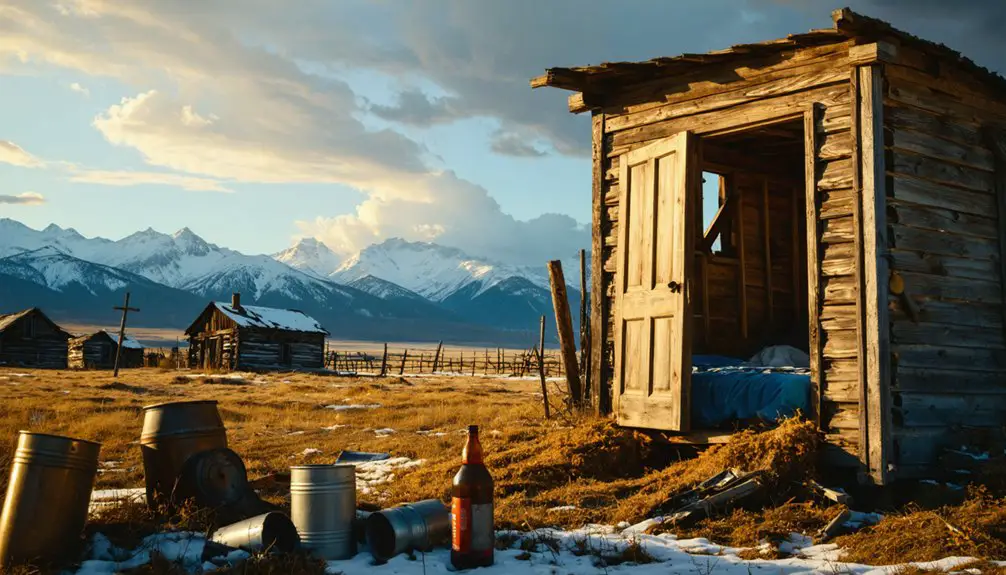You’ll find Perma, Montana nestled in the western part of the state, where it flourished as a gold mining boomtown starting in 1867. Over 1,500 prospectors rushed to the area following major strikes at nearby Bannack City, Alder Gulch, and Last Chance Gulch. The settlement grew rapidly, with new houses appearing daily and mining operations evolving from basic prospecting to advanced cyanide processing by 1900. Today’s ghost town holds fascinating remnants of Montana’s resource-driven past.
Key Takeaways
- Perma emerged as a mining settlement in 1867 during Montana’s gold rush, experiencing rapid growth with approximately one new house built daily.
- The town’s economy centered on gold, silver, and copper extraction, with gold production exceeding $90 million between 1862-1866.
- Residents lived in basic wooden structures and faced challenging frontier conditions including food scarcity and limited medical care.
- The town declined after mineral depletion, leaving behind historical structures now affected by fire damage, vandalism, and environmental decay.
- Today, Perma operates as a ghost town tourist destination offering guided summer tours and hiking trails showcasing Montana’s mining heritage.
The Rise of a Mining Settlement

Three major gold strikes in Montana – at Bannack City in 1862, Alder Gulch in 1863, and Last Chance Gulch in 1864 – set the stage for Perma’s establishment in 1867.
As word spread of Montana’s mineral riches, over 1,500 prospectors rushed to the area, bringing basic gold prospecting tools and dreams of striking it rich.
You’d have witnessed Perma’s explosive growth, with roughly one new house appearing each day.
While early mining technology consisted mainly of backbreaking placer operations, the discovery of silver and manganese deposits diversified the town’s prospects.
The rush created instant wealth – Last Chance Gulch alone yielded $19 million in gold by 1868.
Early miners traveled up the Missouri River to Fort Benton to reach the promising goldfields.
Perma’s mining ventures contributed to Montana’s broader transformation, helping drive its evolution from territory to statehood in 1889.
Like Virginia City, Perma’s population quickly declined as the easily extracted gold ran out.
Life in Early Perma
You’d find the daily routines of early Perma settlers centered around mining activities, with miners rising at dawn to work their claims while support workers like blacksmiths and traders maintained the settlement’s basic needs.
Living conditions proved challenging in the wooden structures and tents that dotted the landscape, where residents relied on local streams for water and dealt with unpaved roads that turned treacherous in bad weather. The local Fort Shaw soldiers occasionally patrolled through the area to maintain security along the Benton-Helena Road. The newly constructed Mullan Road connected the settlement to vital supply routes in 1860.
Despite these hardships, the community came together for social gatherings at trading posts and general stores, where they’d share music, stories, and brief moments of leisure amid their rugged frontier existence.
Daily Pioneer Routines
Life in early Perma revolved around five essential routines that kept the settlement functioning: agriculture, household duties, transportation, crafts, and community gatherings.
Your pioneer chores would start at dawn, tending to crops and livestock that provided daily meals. You’d grow wheat, potatoes, and beans while raising chickens, cows, and pigs for meat and dairy.
Men tackled outdoor labor while women managed household tasks, with children helping wherever needed. You’d preserve food through drying and smoking for winter, cook over wood stoves, and share meals communally.
Travel meant horseback or wagon rides on dirt trails, while communication relied on face-to-face meetings.
You’d craft necessities like clothing and candles, repair tools through blacksmithing, and gather for religious services, dances, and community events that strengthened social bonds.
Frontier Living Conditions
Beyond the daily routines, settlers in early Perma faced stark living conditions that tested their resilience.
You’d find them living in simple log cabins with dirt floors and minimal protection against Montana’s harsh elements. Shelter challenges were constant, as wooden shingles and sod roofs required frequent repairs to keep the weather at bay.
Food scarcity meant you couldn’t rely on store-bought supplies. You’d need to hunt deer and elk, while tending gardens during brief summer months. You’d preserve meat through smoking and salting to survive the winters.
Your clothing would be handmade from animal hides and wool, demanding regular maintenance. Medical care was largely self-administered through home remedies, as doctors were scarce.
You’d communicate with other settlements primarily through irregular mail service and word-of-mouth, leading to significant isolation, especially during winter months.
Community Social Gatherings
Despite Perma’s remote location, social gatherings served as the lifeblood of frontier community bonds. You’d find the town’s multi-story social hall bustling with activity, from billiards on the first floor to dances and performances on the second level.
Similar to Bannack Days, the town hosted lively reenactments and pioneer-themed events that brought the community together.
The maple dance floor could accommodate up to 500 people for community events like concerts, theatrical shows, and holiday celebrations.
In the upper floors, you’d discover secret societies and clubs meeting regularly, strengthening social connections among miners, business owners, and civic leaders.
These gatherings weren’t just about entertainment – they provided essential emotional support and news sharing in an isolated frontier setting. Like the preserved Fraternity Hall in Elkhorn, these social venues became vital survival mechanisms, helping residents cope with hardships while fostering the cultural foundation that defined Perma’s vibrant community spirit.
Natural Resources and Economic Development
When prospectors discovered valuable mineral deposits in Perma during Montana’s mining era, the town’s economic development quickly centered around the extraction of gold, silver, and copper.
The town’s strategic location near established gold camps and the Missouri River created ideal conditions for resource extraction and transportation. Like the notorious Beartown Roughts, local mining communities often dealt with lawlessness during peak production periods. Similar to towns like Kendall, Perma had access to electrical power systems that modernized mining operations.
Perma’s proximity to gold camps and the Missouri River positioned it perfectly for efficient mining operations and mineral transport.
You’ll find Perma’s economic resilience reflected in these key developments:
- Early crude mining methods evolved into efficient cyanide processing by the 1900s
- Diverse local businesses emerged, including blacksmiths and hospitality services
- Technological advances in the 1890s enhanced ore processing capabilities
- Mining operations adapted to challenging terrain and bentonite-rich clay conditions
The town’s prosperity remained directly tied to ore availability until depleted veins eventually triggered economic decline and abandonment, following the typical boom-and-bust pattern of Montana mining communities.
Architectural Legacy and Remaining Structures

The architectural legacy of Perma stands as a tribute to Montana’s frontier ingenuity, with structures built from locally quarried stone and native timber.
You’ll find evidence of the town’s architectural significance in the remaining multi-story buildings that once housed miners’ union halls and social venues. These structures feature sturdy granite exteriors, decorative iron facades, and maple hardwood floors that have withstood decades of Montana’s harsh weather.
The buildings showcase a unique blend of utilitarian design and Victorian elegance, with many structures combining commercial, social, and administrative functions under one roof. Like Saint Marie’s gravel road system, these historic structures have fallen into disrepair over time.
While preservation challenges like fire damage, vandalism, and exposure to the elements have taken their toll, you can still spot original features including finely molded pine trim, plastered walls, and distinct interior decorative moldings that speak to Perma’s prosperous mining era.
Ghost Town Tourism and Preservation
Modern visitors to Perma can experience Montana’s rich mining heritage through carefully preserved historical sites and guided exploration opportunities.
Ghost town preservation efforts balance authenticity with accessibility, allowing you to step back in time while ensuring these historic treasures endure for future generations. Similar to how gold and silver mining drove settlement patterns in towns like Garnet, Perma’s development followed the familiar boom-and-bust cycle of early Montana mining communities.
Tourism management in Perma follows successful models from other Montana ghost towns, focusing on:
- Maintaining structures in a state of arrested decay to preserve their historical integrity
- Providing guided summer tours that enhance your understanding of local mining history
- Creating hiking trails and scenic routes that connect you with both cultural and natural attractions
- Implementing protective measures against vandalism and environmental damage while keeping the site accessible
These preservation practices help sustain Perma’s unique character while providing you with an authentic ghost town experience.
Historical Impact on Montana’s Mining Heritage

During Montana’s early mining era, Perma emerged as part of a transformative period that reshaped the territory’s economic and social landscape.
You’ll find its story woven into Montana’s rich mining heritage, alongside boomtowns like Bannack City and Alder Gulch, which produced over $90 million in gold between 1862 and 1866.
Like many mining settlements, Perma’s development reflected the evolution of mining technology, from labor-intensive placer mining to more sophisticated hard-rock operations.
The Eddy Mining and Milling Company‘s 1905 establishment showcased the area’s potential, with ore values reaching $36 per ton.
However, the town’s economic sustainability faced typical challenges of resource depletion and difficult terrain.
Today, Perma’s abandoned structures stand as evidence to Montana’s boom-and-bust mining legacy, contributing to our understanding of the state’s resource-driven past.
Frequently Asked Questions
What Wildlife Species Are Commonly Encountered Around Perma’s Ghost Town Ruins Today?
Like shadows dancing through time, you’ll spot wildlife sightings of grizzlies, black bears, moose, and elk among the local fauna, while bald eagles soar overhead and trout swim in nearby streams.
Are There Any Documented Paranormal Activities or Ghost Stories From Perma?
You won’t find documented ghost sightings or haunted locations in Perma’s records. Unlike Montana’s well-known paranormal hotspots like Butte and Garnet, this ghost town lacks verified supernatural activity or local legends.
What Native American Tribes Originally Inhabited the Perma Area?
You’d find the Salish and Kootenai tribes calling Perma’s rugged landscape home, with their cultural footprint spanning generations before European settlement. The Crow and Blackfeet also frequented this territory.
Can Metal Detecting Be Legally Conducted at the Perma Site?
You can’t legally metal detect at this site due to metal detecting regulations and historical artifact preservation laws protecting locations over 100 years old, unless you obtain special archaeological permits.
Which Family Names Were Most Prominent Among Perma’s Early Settlers?
Want to know who shaped Perma’s beginnings? Records show the O’Donnell, Crowley, and Remington settler families held historical significance, while the Olson, Williams, and Wright families also established deep community roots.
References
- https://www.montanaliving.com/blogs/destinations/explore-montana-ghost-towns
- https://www.geotab.com/ghost-towns/
- https://www.youtube.com/watch?v=LhR2iTWvo30
- https://theriver979.com/montana-ghost-towns/
- https://centralmontana.com/blog/visiting-the-ghost-town-of-kendall-in-central-montana/
- https://mhs.mt.gov/education/textbook/chapter6/Chapter6.pdf
- https://www.perceptivetravel.com/issues/0620/montana.html
- https://discoveringmontana.com/history-of-the-gold-rush/
- https://montanakids.com/agriculture_and_business/mining/Early_days_of_Mining.htm
- https://npshistory.com/publications/usfs/region/1/flathead/history/chap3.htm



